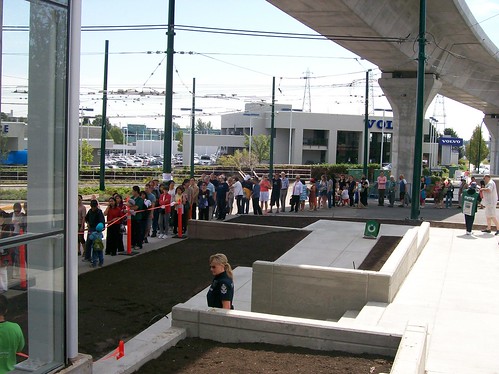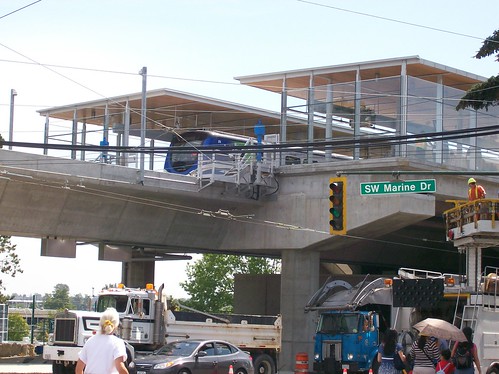
This is a bit belated, but I did managed to get over to Vancouver for the opening of the Canada Line, the newest addition to the SkyTrain network. First, a little bit of history. The Canada Line is a Public-Private Partnership, something that the BC Gov forced onto Translink as a condition of provincial funding. This means that it is actually operated by ProTrans BC and was built by InTransitBC, both largely owned by SNC Lavelin out of Montreal. The federal government demanding Translink call it the Canada Line as a condition of their funding.
That being said, Vancouver is the first Canadian city to have a direct rail link to the airport, something common in Europe as well as a few US cities like Portland.
Given I was coming from across the pond, I ended up starting at the Marine Drive station, just north of the Fraser. This turned out to be a good decision, because lines for northbound (Waterfront Station-bound) trains were fairly quiet, at least in the morning.

The Marine Drive station is pretty indicative of the elevated stations on the line. Lots of wood and glass. They were attractive, but the platforms were short, as can be seen in the second photo down, coming into one of the underground stations.


The stations also seriously lacked amenities. There were no bathrooms and few chairs in most of the stations. The stairs were narrow, with only escalators going up. Overall, the stations felt quickly built and cheap, as attractive as some of them were.
The cars themselves were fairly spacious, wider than the newer Mark II cars on the Skytrain. The had a single space for a bicycle and another for wheelchairs, both in one of the two cars.

The ride was smooth and fairly fast, especially compared to the old 98 B-line “bus rapid transit” or the even older Expo Line. The Expo Line now has some sections of track cause a lot of noise and sway, especially with the older Mark I SkyTrain cars.
One of the challenges with connections was that the bus lines haven’t yet been adjusted, something is coming with Labour Day. Both the 98 B-line and the 424 to the Airport are going away, while the 620 from Tsawwassen will be routed into Bridgeport Station. This is just some of the large number of bus changes coming, some of which are not making people very happy. Many people are now going to have to take both a bus and the Canada Line to downtown, as opposed to a single seat bus ride.
As can be expected for the opening of a major new transit line, the lines were crazy all day. Waterfront Station was especially bad, with waits running past an hour, from what I understand.
Overall, I am glad the Canada Line exists, but I think there are going to be serious capacity issues in the future. With the short platforms leading to inability to run larger trains, unlike the Skytrain system, expect crush capacity cars of 400 people very shortly. The real test will come this fall, so it should be interesting to see those numbers. To see more pictures, see my Flickr set.
The line was built to service a specific volume of traffic that has been projected for the line.
The traffic volume projections have been critized as being optimistic, so I expect that the stations will be able to handle the volumes.
The stations are comparable to a lot of the existing stations on the older two lines. SkyTrain has never had a lot of amenities at the stations.
Do you feel it was a bad idea to build it as a P3? The Canada Line was finished significantly early and was on budget, one of the few LRTs in North America in the last 20 years to achieve either.
Yes, the line was built to the minimum spec. The Victoria Line in London is a classic example of just how long building to minimum spec can hurt. And yes, with the exception of platform length, the amenities are similar. This doesn’t mean that is a good thing.
Traffic volumes have been declared optimistic for every single rail system in North America for the past 50 years and in the past 10 or so, they have actually proven conservative.
As for the P3 bit, I haven’t seen any proof that building this as a P3 saved any money or time, especially in the long term, given the issues I mentioned in the post.
I should also mention that the proposed Ottawa LRT is considering using 180m platforms, 30m longer than the current BRT system has – http://www.friendsoftheotrain.org/node/204